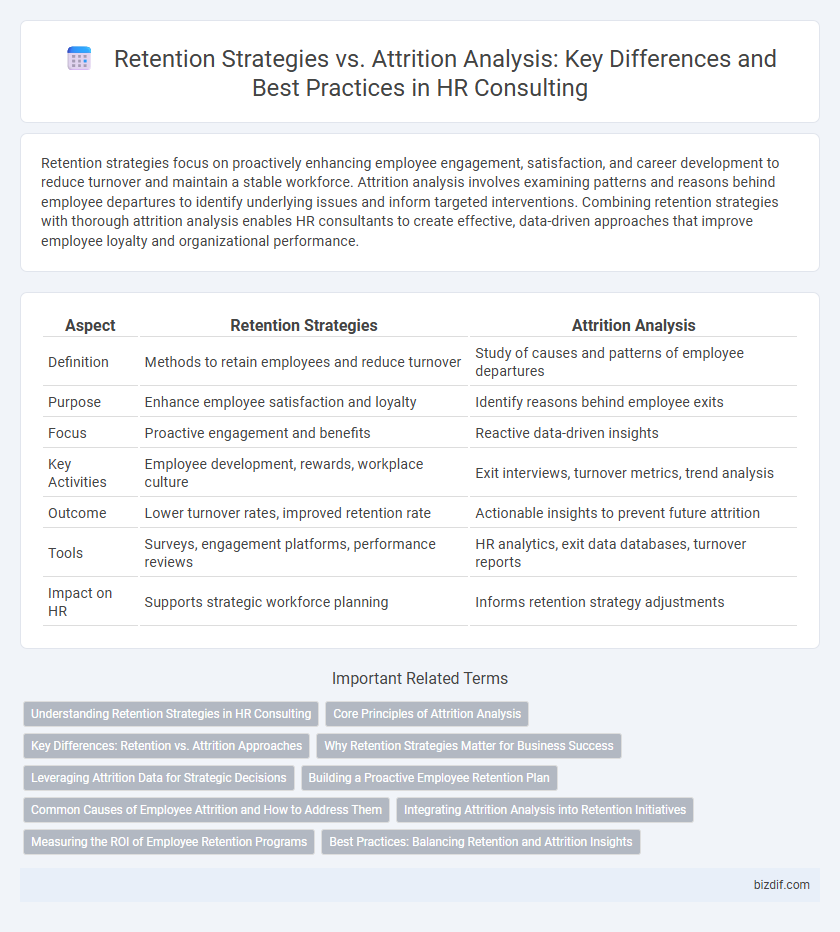Retention strategies focus on proactively enhancing employee engagement, satisfaction, and career development to reduce turnover and maintain a stable workforce. Attrition analysis involves examining patterns and reasons behind employee departures to identify underlying issues and inform targeted interventions. Combining retention strategies with thorough attrition analysis enables HR consultants to create effective, data-driven approaches that improve employee loyalty and organizational performance.
Table of Comparison
| Aspect | Retention Strategies | Attrition Analysis |
|---|---|---|
| Definition | Methods to retain employees and reduce turnover | Study of causes and patterns of employee departures |
| Purpose | Enhance employee satisfaction and loyalty | Identify reasons behind employee exits |
| Focus | Proactive engagement and benefits | Reactive data-driven insights |
| Key Activities | Employee development, rewards, workplace culture | Exit interviews, turnover metrics, trend analysis |
| Outcome | Lower turnover rates, improved retention rate | Actionable insights to prevent future attrition |
| Tools | Surveys, engagement platforms, performance reviews | HR analytics, exit data databases, turnover reports |
| Impact on HR | Supports strategic workforce planning | Informs retention strategy adjustments |
Understanding Retention Strategies in HR Consulting
Retention strategies in HR consulting focus on identifying and implementing effective methods to keep high-performing employees engaged and satisfied, thereby reducing turnover rates and minimizing recruitment costs. These strategies often include career development opportunities, competitive compensation packages, and fostering a positive organizational culture tailored to employee needs. Understanding the specific factors driving employee retention enables HR consultants to design customized programs that align with business goals and improve overall workforce stability.
Core Principles of Attrition Analysis
Attrition analysis centers on identifying patterns and root causes of employee turnover using quantitative data such as exit interviews, turnover rates, and demographic trends. Core principles include segmenting attrition by voluntary or involuntary departure, analyzing job satisfaction metrics, and assessing external labor market conditions to inform retention strategies. This analytical approach enables HR consultants to develop targeted interventions that reduce turnover and enhance workforce stability.
Key Differences: Retention vs. Attrition Approaches
Retention strategies focus on proactive measures like employee engagement programs, career development opportunities, and competitive compensation to minimize turnover, while attrition analysis involves examining the reasons behind employee departures through exit interviews, turnover metrics, and trend identification. Retention approaches prioritize maintaining a motivated workforce to enhance productivity and reduce recruitment costs, whereas attrition analysis provides critical insights for strategic adjustments by understanding patterns and causes of employee loss. Both methods are integral to a comprehensive HR strategy but differ in timing and focus--retention is preventive, whereas attrition is diagnostic.
Why Retention Strategies Matter for Business Success
Retention strategies are crucial for business success as they directly reduce turnover costs, preserve institutional knowledge, and enhance employee engagement. Implementing data-driven retention initiatives helps identify and address key factors causing attrition, leading to stronger workforce stability and increased productivity. Focusing on retention optimizes talent management, improves organizational culture, and drives sustainable growth.
Leveraging Attrition Data for Strategic Decisions
Leveraging attrition data enables HR consultants to identify patterns and root causes of employee turnover, providing actionable insights for retention strategies. By analyzing exit interviews, turnover rates, and demographic trends, organizations can implement targeted initiatives such as personalized career development and improved workplace culture. This data-driven approach optimizes workforce stability and reduces recruitment costs, enhancing overall organizational performance.
Building a Proactive Employee Retention Plan
Effective retention strategies hinge on data-driven attrition analysis to identify key factors influencing employee turnover. By leveraging predictive analytics and employee feedback, HR consulting firms can design proactive retention plans that address root causes such as job satisfaction, career development opportunities, and workplace culture. Implementing tailored retention initiatives reduces costly attrition rates and fosters long-term organizational stability.
Common Causes of Employee Attrition and How to Address Them
Common causes of employee attrition include lack of career growth, inadequate compensation, and poor work-life balance. Addressing these issues involves implementing clear career development plans, conducting regular salary benchmarking, and promoting flexible work arrangements. Effective retention strategies also require continuous feedback mechanisms and fostering a positive organizational culture to enhance employee engagement and reduce turnover rates.
Integrating Attrition Analysis into Retention Initiatives
Integrating attrition analysis into retention initiatives enables HR consultants to identify key factors contributing to employee turnover and tailor strategies that effectively address underlying issues. Analyzing patterns such as exit interview feedback, tenure data, and departmental trends provides actionable insights to improve employee satisfaction and engagement. Leveraging this data-driven approach enhances retention rates by targeting specific pain points and aligning retention programs with organizational goals.
Measuring the ROI of Employee Retention Programs
Measuring the ROI of employee retention programs involves comparing the financial impact of reduced turnover against the costs of implementing retention strategies. Effective retention strategies, such as career development and employee engagement initiatives, directly contribute to lower attrition rates, enhancing organizational stability. Quantifying savings from decreased recruitment, onboarding, and training expenses allows HR consultants to demonstrate the value and effectiveness of targeted retention efforts.
Best Practices: Balancing Retention and Attrition Insights
Effective retention strategies leverage attrition analysis to identify key factors driving employee turnover, enabling targeted interventions that enhance engagement and reduce flight risk. Best practices include continuous monitoring of turnover metrics, implementing feedback loops through exit interviews, and fostering a culture that addresses both organizational and individual needs. Balancing retention efforts with insights from attrition data ensures resource optimization and sustainable workforce stability.
Retention Strategies vs Attrition Analysis Infographic

 bizdif.com
bizdif.com